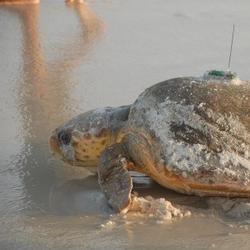USGS scientists Daniel Catizone (left) and David Seay (center) joined federal and state workers and volunteers in rescuing an estimated 1,000 cold-stunned sea turtles, making this the second largest sea turtle rescue of the 21st century. Photo by Margaret Lamont, USGS
Daniel Catizone
Dan Catizone is a Biologist with the USGS Wetland and Aquatic Research Center.
Education and Certifications
M.S., Interdisciplinary Ecology, University of Florida, 2021
B.S., Wildlife Conservation Biology, University of Rhode Island, 2015
Science and Products
Diamondback terrapin resource use in a seagrass-dominated coastal bay varies by life stage Diamondback terrapin resource use in a seagrass-dominated coastal bay varies by life stage
Demographics of a previously undocumented diamondback terrapin (Malaclemys terrapin) population Demographics of a previously undocumented diamondback terrapin (Malaclemys terrapin) population
Satellite telemetry reveals space use of diamondback terrapins Satellite telemetry reveals space use of diamondback terrapins
Conservation action plan for diamond-backed terrapins in the Gulf of Mexico Conservation action plan for diamond-backed terrapins in the Gulf of Mexico
Coastal observations of alligator snapping turtles in the Florida Panhandle Coastal observations of alligator snapping turtles in the Florida Panhandle
Home ranges and movements of two diamondback terrapins (Malaclemys terrapin macrospilota) in northwest Florida Home ranges and movements of two diamondback terrapins (Malaclemys terrapin macrospilota) in northwest Florida
Movements of marine and estuarine turtles during Hurricane Michael Movements of marine and estuarine turtles during Hurricane Michael
Malaclemys terrapin (Diamondback terrapin) Lepadomorph epibionts Malaclemys terrapin (Diamondback terrapin) Lepadomorph epibionts
USGS Provides Mission Support on Eglin Air Force Base: Coastal and Marine Species Science
Management of Gopher Tortoise (Gopherus polyphemus) Using Coastal Habitats
Ecology of the Diamondback Terrapin: Demographics, Movements, and Habitat Use
Diamondback terrapins and their potential diet isotope values and associated metadata collected 2018-2021 in St. Joseph Bay, Florida Diamondback terrapins and their potential diet isotope values and associated metadata collected 2018-2021 in St. Joseph Bay, Florida
USGS scientists Daniel Catizone (left) and David Seay (center) joined federal and state workers and volunteers in rescuing an estimated 1,000 cold-stunned sea turtles, making this the second largest sea turtle rescue of the 21st century. Photo by Margaret Lamont, USGS
Science and Products
Diamondback terrapin resource use in a seagrass-dominated coastal bay varies by life stage Diamondback terrapin resource use in a seagrass-dominated coastal bay varies by life stage
Demographics of a previously undocumented diamondback terrapin (Malaclemys terrapin) population Demographics of a previously undocumented diamondback terrapin (Malaclemys terrapin) population
Satellite telemetry reveals space use of diamondback terrapins Satellite telemetry reveals space use of diamondback terrapins
Conservation action plan for diamond-backed terrapins in the Gulf of Mexico Conservation action plan for diamond-backed terrapins in the Gulf of Mexico
Coastal observations of alligator snapping turtles in the Florida Panhandle Coastal observations of alligator snapping turtles in the Florida Panhandle
Home ranges and movements of two diamondback terrapins (Malaclemys terrapin macrospilota) in northwest Florida Home ranges and movements of two diamondback terrapins (Malaclemys terrapin macrospilota) in northwest Florida
Movements of marine and estuarine turtles during Hurricane Michael Movements of marine and estuarine turtles during Hurricane Michael
Malaclemys terrapin (Diamondback terrapin) Lepadomorph epibionts Malaclemys terrapin (Diamondback terrapin) Lepadomorph epibionts
USGS Provides Mission Support on Eglin Air Force Base: Coastal and Marine Species Science
Management of Gopher Tortoise (Gopherus polyphemus) Using Coastal Habitats
Ecology of the Diamondback Terrapin: Demographics, Movements, and Habitat Use
Diamondback terrapins and their potential diet isotope values and associated metadata collected 2018-2021 in St. Joseph Bay, Florida Diamondback terrapins and their potential diet isotope values and associated metadata collected 2018-2021 in St. Joseph Bay, Florida
USGS scientists Daniel Catizone (left) and David Seay (center) joined federal and state workers and volunteers in rescuing an estimated 1,000 cold-stunned sea turtles, making this the second largest sea turtle rescue of the 21st century. Photo by Margaret Lamont, USGS
USGS scientists Daniel Catizone (left) and David Seay (center) joined federal and state workers and volunteers in rescuing an estimated 1,000 cold-stunned sea turtles, making this the second largest sea turtle rescue of the 21st century. Photo by Margaret Lamont, USGS







